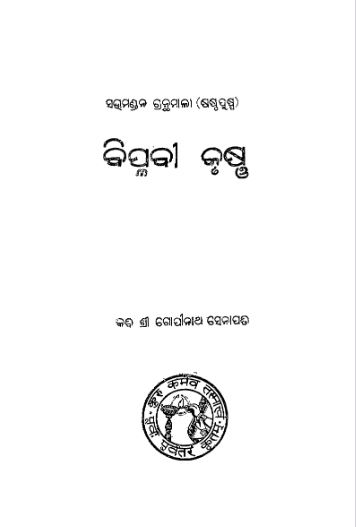Biplabi Krusna, penned by the eminent Odia poet Gopinath Senapati, stands as a significant contribution to the corpus of Odia literature. First published in 1984, this collection of poems is not merely a work of art; it is a lyrical exploration of devotion that delves into the intricate relationship between humanity and the divine. Senapati, known for his evocative language and profound themes, crafts each poem in this anthology to resonate with the spiritual thirst and longing that is often inherent in human existence.
At the heart of “Biplabi Krusna” lies a vibrant portrayal of Lord Krishna, who is celebrated not only as a deity but as a symbol of rebellion, love, and wisdom. The title itself, translating to “Revolutionary Krishna,” hints at the thematic undercurrents that run throughout the book. Senapati encapsulates the essence of Krishna as a figure who embodies divine love and revolutionary spirit, challenging the established norms and inviting individuals to seek a deeper connection with the divine.
The collection is divided into several sub-poems, each accentuating various aspects of devotion. Senapati’s portrayal of Krishna transcends mere mythology; it integrates elements of philosophy, social commentary, and personal introspection, creating a multi-layered tapestry of thought. Through vivid imagery and emotive language, the poet invites readers to engage in a dialogue with the divine, urging them to explore their own spirituality and place within the cosmos.
One of the standout characteristics of “Biplabi Krusna” is its rhythmic elegance, which draws readers into the lyrical dance of words. Senapati’s command over the Odia language is evident as he skillfully employs meter and cadence to enhance the devotional experience. The poems are rich with vivid metaphors, similes, and allegorical references that rejuvenate the age-old tales of Krishna, infusing them with contemporary relevance.
In “Biplabi Krusna,” the motif of love plays a crucial role. Senapati illustrates the complexities of divine love, showcasing the idea that true devotion requires not just admiration but an active participation in the divine will. The poems explore the emotional spectrum of devotion—ranging from the bliss of surrender to the pangs of separation—reflecting the myriad feelings that accompany a soul’s journey toward union with the beloved.
Furthermore, Senapati does not shy away from addressing societal issues within the framework of spirituality. He uses the character of Krishna as a revolutionary force, emphasizing the need for social justice and change. This perspective resonates powerfully in modern contexts, as it challenges readers to reflect on their own roles as agents of change within their communities while remaining anchored in their spiritual beliefs.
The devotional aspect of the poems is palpable, inviting readers to participate in a shared spiritual experience. As they traverse through the pages, they are offered glimpses of transcendence, prompting a meditative state that encourages self-reflection and growth.
In conclusion, “Biplabi Krusna” by Gopinath Senapati is not just an anthology of poems; it is an evocative exploration of devotion, love, and revolution. By weaving together spirituality with social consciousness, Senapati has created a timeless work that resonates deeply with seekers of truth and beauty. Readers of all backgrounds are likely to find themselves enriched by the profound messages embedded in these verses, making “Biplabi Krusna” a cherished gem in the realm of Odia literature.
Books Info
| Books name | Biplabi Krusna |
| Author | Gopinath Senapati |
| No Of pages | 133 |
| Publisher | NA |
| Publication | 1984 |
| Printed At | Gyana Prakashani |
| Distributor | NA |

